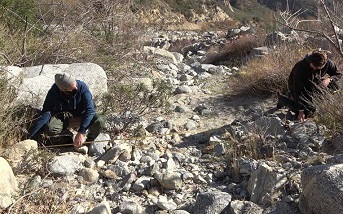Tool released to help determine whether streams subject to Clean Water Act oversight

A SCCWRP-developed tool that can help watershed managers determine which streams the federal government has jurisdiction to regulate under the Clean Water Act has been released in beta form for use across the nation’s arid western states.
The Streamflow Duration Assessment Method for the Arid West (SDAM AW), released in March by the EPA and the U.S. Army Corps of Engineers, is designed to help managers rapidly distinguish among intermittent, ephemeral and perennial stream reaches.
This distinction is important because under a rule change finalized in early 2020 by the Trump administration, entities that discharge into certain ephemeral streams may not be required to obtain discharge permits from the federal government.
In Southern California, the SDAM AW tool also can be used to help identify stream reaches that watershed managers would vs. wouldn’t want to consider evaluating during routine stream assessments, and to identify stream reaches where stream biological integrity goals may vs. may not apply.
Ephemeral streams, which are streams that only experience brief surface flows as a direct result of rain events, are often difficult to distinguish from intermittent streams, which experience sustained seasonal flows from snow melt and groundwater, unless managers have collected long-term hydrologic data for the site.
In recent years, the EPA has prioritized improving regulatory agencies’ ability to distinguish among different stream types. Traditionally, distinguishing ephemeral streams from intermittent streams has required obtaining long-term records from gauges or rigorous hydrologic models – neither of which exists for most streams.
The SDAM AW tool determines the duration of stream flows using easily observed field indicators, including wetland vegetation and aquatic invertebrates.
Although California does not distinguish among ephemeral, intermittent and perennial streams under the Porter-Cologne Water Quality Control Act of 1969, the tool is being used for more than just jurisdictional determination. For example, watershed managers plan to use the tool to map the locations of intermittent and perennial stream reaches across Southern California during the next cycle of the Southern California Stormwater Monitoring Coalition (SMC) Regional Watershed Monitoring Program, which kicks off this spring.
A number of court cases that center around the Clean Water Act have underscored the importance of being able to distinguish among streams by their flow patterns. For example, the 2006 Supreme Court case Rapanos V. U.S. affirmed that the Clean Water Act applies only to traditionally navigable waters and to tributaries that have a “significant hydrologic nexus” with navigable waters.
In interpreting these court decisions, the executive branch then typically uses stream flow duration information as the basis for developing rules clarifying the Clean Water Act’s applicability to streams.
SCCWRP’s SDAM AW tool has resonated with the EPA, which has asked SCCWRP to develop comparable versions of the SDAM AW tool for other regions of the U.S., including Western Mountains and Great Plains.
To support the tool’s implementation across the Arid West, SCCWRP has created a user manual, field data collection forms, a report generating tool, and extensive training resources – all available through a central hub.
The beta version of the SDAM AW tool is expected to be finalized about a year from now.
For more information, contact Dr. Raphael Mazor.
More news related to: Bioassessment, Ecohydrology, Top News